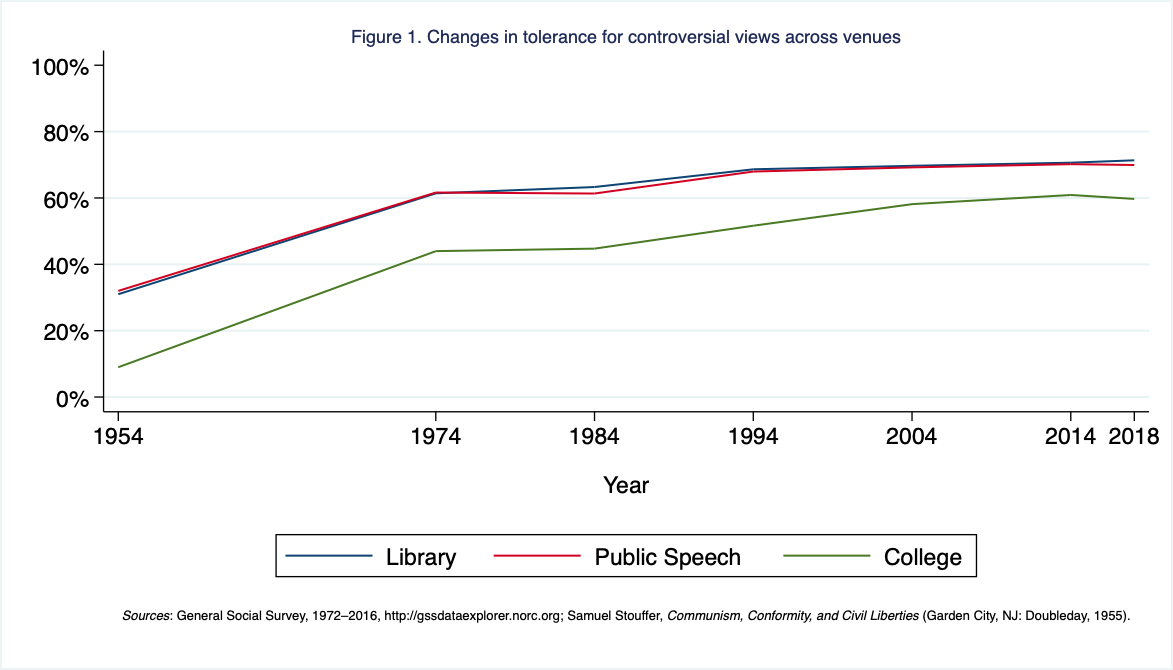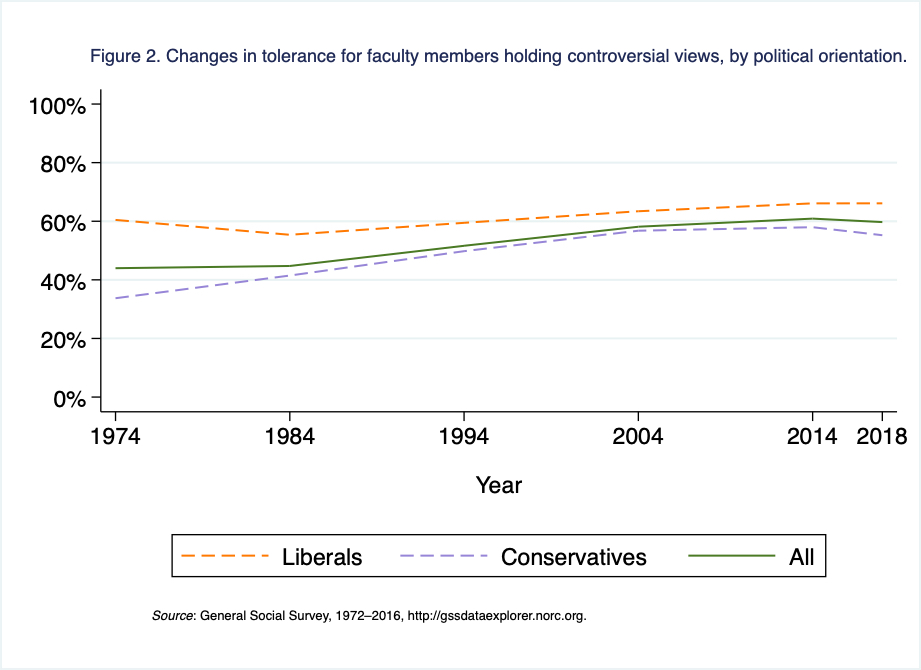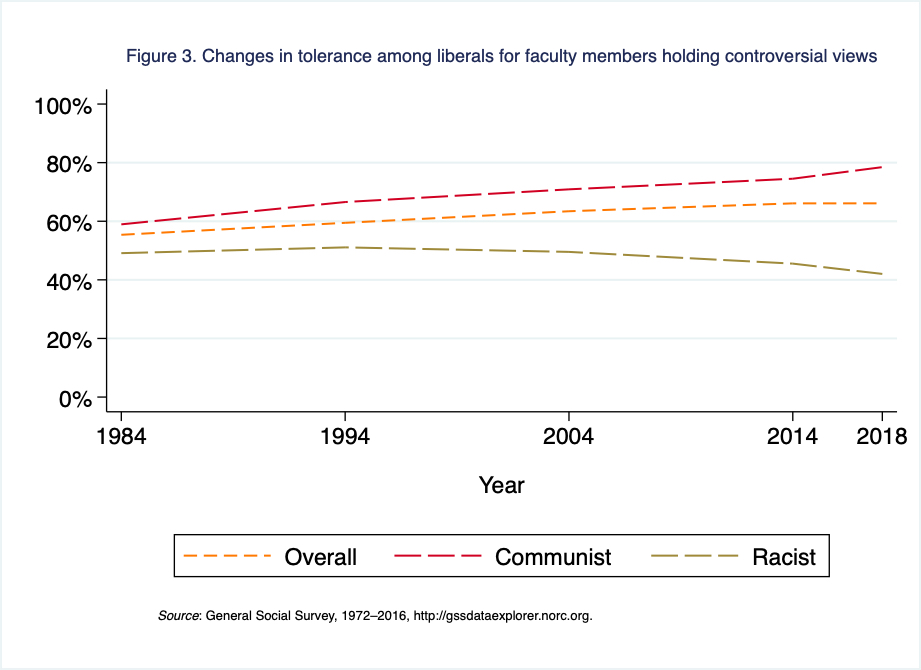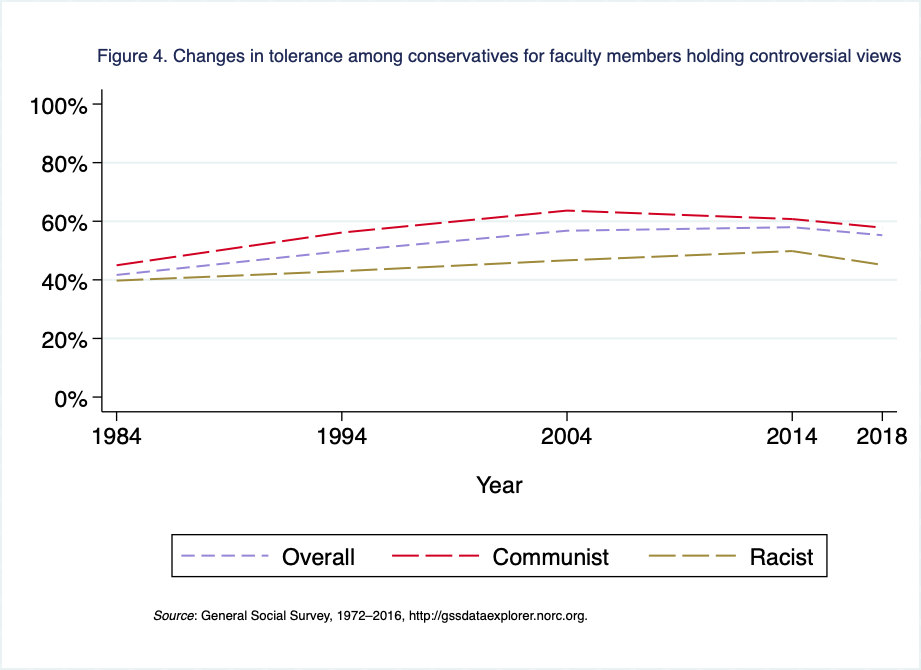- About
- Programs
- Resources
- For AFT Higher Ed Members
- Academic Freedom
- Shared Governance
- Campus Protests
- Faculty Compensation
- Political Interference in Higher Ed
- Racial Justice
- Diversity in Higher Ed
- Responding to Financial Crisis
- Privatization and OPMs
- Contingent Faculty Positions
- Tenure
- Workplace Issues
- Gender and Sexuality in Higher Ed
- Targeted Harassment
- Intellectual Property & Copyright
- Free Speech on Campus
- Civility
- Publications
- Data
- News
- Membership
- Chapters
Data Snapshot: Survey Data on Attitudes toward Faculty Freedom of Expression
How might political views influence attitudes toward academic freedom?
It is by now well established that the current highly polarized political atmosphere is reflected in attitudes toward higher education. The findings in this data snapshot show that support for faculty freedom of expression has been falling in recent years, particularly among those who hold conservative views. Recent findings about differences in attitudes toward higher education between liberals and conservatives may be related to attitudes toward academic freedom as well.
The definition of academic freedom that the AAUP has advocated since its founding includes as a constitutive element the freedom of extramural speech—speech outside of the university that may address matters of public concern and that may be unrelated to the professional expertise of faculty members. The freedom of faculty members to hold and express views that are unpopular or outside of the mainstream, however, is frequently called into question, and summary dismissals of faculty members for their extramural speech are legion among the cases investigated by the AAUP. In some prominent instances, such as the case of Steven Salaita at the University of Illinois at Urbana-Champaign, administrators have received demands from the public for the dismissal of faculty members because of their speech, which raises questions about how widespread public support is for faculty members who hold or express unpopular views.
Empirical research on political tolerance has a long tradition within the social sciences, dating at least to sociologist Samuel Stouffer’s 1954 study, conducted during the McCarthy era, of public attitudes toward communism. Stouffer asked a nationally representative sample of respondents whether books by authors with “nonconformist” beliefs should be banned, whether speakers who hold such beliefs should be given a public forum, or whether professors who hold such beliefs should be fired. The specific beliefs about which Stouffer asked included communism and atheism. The General Social Survey, a large national survey on social views that has been conducted regularly since 1972, incorporated some of Stouffer’s survey items from the beginning and subsequently enlarged them to include questions about individuals who hold “right-wing” beliefs, such as the view that African Americans are genetically inferior or that the government should be replaced by a military dictatorship.
Table 1 lists the views and hypothetical venues in which individuals might express them included in both surveys. The four views and three venues yield a total of twelve questions about each view in each venue. The gendered language of some of the questions dates to Stouffer’s original survey.
Table 1. Survey items about individuals holding and expressing unpopular views
|
View |
Venue |
|
Communist: “A man who admits he is a communist.” |
Library: “Suppose he wrote a book which is in your public library. Somebody in your community suggests the book be removed from the library. Would you favor removing it or not?” |
|
Atheist: “Somebody who is against all churches and religion.” |
Public Speech: “Suppose [someone who holds this view] wants to make a speech in your community. Should he be allowed to speak or not?” |
|
Racist: “A person who believes Blacks are genetically inferior.” Added in 1976. |
College: “Suppose he is teaching in a college. Should he be fired or not?” |
|
Militarist: “A person who advocates doing away with elections and letting the military run the country.” Added in 1976. |
|
The average percentage of respondents who support free expression in the three venues across the various views over the last six decades is summarized in figure 1. Two impressions stand out. First, there is a consistent gap between tolerance for professors, on the one hand, and tolerance for speakers and authors, on the other. Second, while the figure demonstrates what sociologist James Davis termed “the seemingly relentless progress in Americans’ support for free expression,” tolerance for professors holding controversial views has recently begun to decline, and thus the gap has begun to widen again, if only slightly. What possible explanations exist for the latter phenomenon?

From the perspective of the work of the AAUP, questions that assess tolerance for faculty members holding controversial views are of particular interest. It is important to stress that the survey questions as posed give no indication that the faculty members are acting on the views ascribed to them in any way that would violate professional ethics—such as, say, grading students on the basis of their views, their race, or their ethnicity—or that would suggest disciplinary incompetence. The AAUP has long held that serious violations of professional ethics or incompetence can be grounds for discipline and dismissal, as long as AAUP-supported standards for academic due process are followed. But the AAUP has also long taken the position that holding certain views or joining a political party or movement, in and of itself, is not grounds for dismissal. Again, the Stouffer questions do not cite any evidence of unfitness but merely ask about the removal of the faculty member on the basis of the views held. Thus, the overall finding that support for faculty freedom of expression is less than 60 percent on average is troubling.
Stouffer and others who followed his approach have focused particularly on how differences in age and in educational attainment affected responses to questions on political tolerance. Recent findings on a “partisan divide” in views on higher education—such as those reported by the Pew Research Center, which found that 59 percent of Republicans and those leaning Republican have a negative view of higher education, compared with 18 percent of Democrats and those leaning Democratic—raise questions about how responses to the Stouffer items may differ based on the political views of the respondent. The General Social Survey asks respondents to place themselves on a continuum of political views ranging from “extremely liberal” to “extremely conservative,” which allows for an analysis of the relationship between political views and answers to the questions.
As figure 2 illustrates, a consistent gap exists between liberals and conservatives in response to the question about whether faculty members who hold certain views should be dismissed. Moreover, the responses from conservatives began to flatten in 2004 after years of increase in tolerance and has dropped off in recent years. The responses for liberals have flattened in recent years as well. (For the purposes of this analysis, I have identified those who placed themselves into the “extremely liberal,” “liberal,” or “slightly liberal” categories as “liberal” and used an analogous grouping for conservatives.)

When analyzed more closely, the responses within each of the two groups to questions about whether a racists or communists should be permitted to be college professors show an interesting divergence: the responses of liberals split, with decreasing tolerance of those holding racist views and increasing tolerance of those holding communist views, while the responses of conservatives decline somewhat in parallel.


The divergence between the two groups seen in figures 3 and 4 raises several questions, the full analysis of which falls outside of the scope of this data snapshot. One way to think about the difference between the two figures is that liberals seem to differentiate more between the views that are being assessed—that is, they are less consistent in their response across venues—while conservatives place less emphasis on the views themselves and more emphasis on the venue, college. Conservatives thus are more consistent in their response that academics who hold controversial views—no matter what views—should be dismissed. This observation, which can be investigated with more sophisticated statistical tools not discussed here, suggests that conservatives’ attitudes toward higher education are reflected in attitudes toward academic freedom.
Further Reading
Davis, James A. “On the Seemingly Relentless Progress in Americans’ Support for Free Expression, 1972–2006.” In Social Trends in American Life: Findings from the General Social Survey since 1972, edited by Peter V. Marsden. Princeton, NJ: Princeton University Press, 2012.
Stouffer, Samuel. Communism, Conformity and Civil Liberties: A Cross Section of the Nation Speaks Its Mind. Garden City, NY: Doubleday, 1955.
Hans-Joerg Tiede is a senior program officer and researcher at the AAUP. His email address is [email protected].


